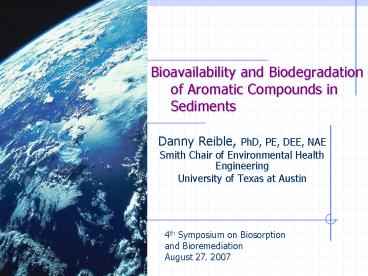Bioavailability and Biodegradation of Aromatic Compounds in Sediments - PowerPoint PPT Presentation
1 / 21
Title:
Bioavailability and Biodegradation of Aromatic Compounds in Sediments
Description:
Characterization of dominant electron acceptor transitions due to benthic ... define risk (direct and food chain transport) of contaminated sediments ... – PowerPoint PPT presentation
Number of Views:143
Avg rating:3.0/5.0
Title: Bioavailability and Biodegradation of Aromatic Compounds in Sediments
1
Bioavailability and Biodegradation of Aromatic
Compounds in Sediments
- Danny Reible, PhD, PE, DEE, NAE
- Smith Chair of Environmental Health Engineering
- University of Texas at Austin
4th Symposium on Biosorption and
Bioremediation August 27. 2007
2
Routes of Contaminant Exposure to Sediments
- Direct flux to water
- Sediment erosion
- Bioturbation and surface release
- Physicochemical processes
- Accumulation in benthic organisms and food chain
transfer - Conclusion - In stable (non-erosive environments)
benthic organisms largely control contaminant
release and exposure
3
Bioturbation
- Normal life cycle activities of benthic organisms
leading to sediment mixing and transport - Dominated by deposit feeders that ingest sediment
e.g. freshwater oligochaetes - Densities up to 100,000 worms/m2 or more
- Organisms may process 10-20 times their wt/day
- Controls depth of sediments leading to exposure
- Controls rate of sediment reworking, sediment
redox conditions and porewater release of
contaminants - Bioturbation may lead to degradation via organism
metabolism - Bioavailability largely defined by what can be
moved or metabolized by or accumulate in benthic
organisms
4
The Bioturbation/Soluble Release Process
5
Current work on biodegradation in sediments
- Characterization of dominant electron acceptor
transitions due to benthic organism activity
using sub-mm resolution voltammetry - Characterization of microbial community changes
in response to dominant electron acceptor
transitions - Special focus on chlorinated benzenes
- Dechlorination of multi-chlorinated benzenes
under strongly reducing conditions - Oxidation of monochlorobenzene in transitional
and aerobic zone created by benthic organisms - This lecture
- General effects of benthic organism affects on
sediment and contaminants - Extension of past laboratory work on assessing
availability of desorption resistant contaminants
to benthic organism (i.e. effect of contaminants
on organisms)
6
Bioturbation Particle Diffusion Rates
Freshwater and Estuarine Systems
7
Bioturbation Mixing Depths
Freshwater and Estuarine Systems
8
Effects of BioturbationMicrocosm Experiments
9
Effects of BioturbationContaminant Fate
10
Effects of Contamination on Benthic
OrganismsWhole Sediment Concentration ???
Non- Toxic
Toxic
Adapted from Dave Nakles, ENSR
11
Effects of Contamination on Benthic
OrganismsInterstitial Water Concentration
EPA H. azteca 28-day test
Survival ()
Non- Toxic
Toxic
Sediment Porewater PAH34 Conc. (Toxic Units)
Adapted from Dave Nakles, ENSR
12
Metrics - Correlation (?) of PCB Uptake with
Whole Sediment Concentration
Anacostia River
13
Accumulation Predicted by Porewater?Predicted vs
Measured BSAF - PCBS
Anacostia River
14
Laboratory Correlation of PAH Uptake with
Interstitial Water Concentration
Anacostia River
Assuming KlipidKoc
Porewater
15
But How to Measure Porewater Concentration?
- Solid Phase MicroExtraction
- Sorbent Polymer PDMS (poly-dimethylsiloxane)
- Thickness of glass core 114-108 µm
- Thickness of PDMS coating 30-31 µm
- Volume of coating 13.55 (0.02) µL PDMS per
meter of fibre - Easily capable of measuring ng/L concentrations
16
Field Deployment System
17
Field Deployment with Caged Lumbriculus
18
Does it Work in the Field?Field Deployed SPME
with Accumulation in Caged Lumbriculus
Assuming KlipidKoc
19
Anacostia Sediment Porewater Concentration
Contaminants exhibit low availability compared
to the expected whole sediment concentration
20
SPME Measured Porewater Concentrations
21
Summary and Conclusions
- Bioturbation dominant mechanism for defining
contaminant fate and transport in non-erosive
sediments - Benthic organisms responsible for bioturbation
define risk (direct and food chain transport) of
contaminated sediments - Benthic organisms dramatically affect near
surface redox conditions and contaminant dynamics - Interstitial water (porewater) concentrations
better indicator of exposure and risk than whole
sediment concentration even for contaminants
whose uptake is controlled by ingestion - Field-deployable SPME simple and useful to define
exposure and risk































